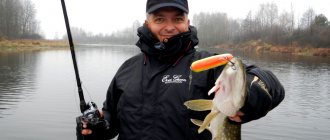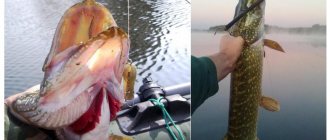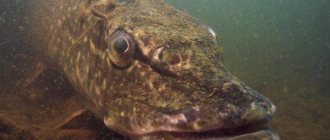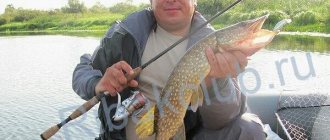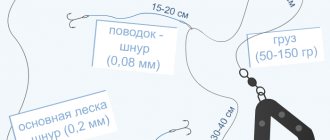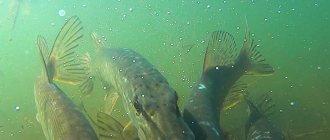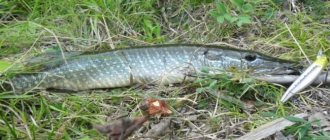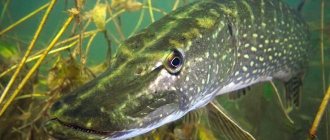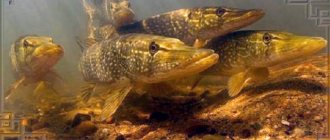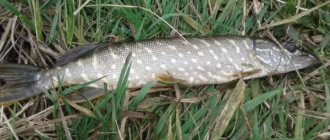Yuri 11/26/2020 366
What to do when it doesn’t bite and how to deal with it? This question would not be so relevant if we were talking about catching minnows or small perch, on a quiet evening on the river bank, just for fun. But how to solve the problem if the fishing was planned in advance and the object of the hunt is such a serious rival as pike?
Quite often you can hear the opinion from people who are far from fishing that the pike is stupid and unceremoniously grabs any bait. And if the toothy beast doesn’t bite, then it’s not in this place at all. This statement is dangerous because it becomes a dogma for many beginning spinning players. As a result of this, an inexperienced fisherman does not even try to find out the reason for the lack of bites. As a result, the baggage of experience is not replenished, the quality of fishing becomes worse.
Today we will talk about why a shortage of predator bites does not mean its absence in a particular place, as well as what tactics to choose for catching passive pike.
We invite you to look at our photos where fishermen show off the pike they caught at the Sazanya Bukhta fishing base.
Pike bindings
When searching for pike, you always get attached to something, trying not just to stir up water with bait, but to do it consciously. There are reservoirs where the hours when pike come out to feed fall only in the evening. But there are places where you can really catch a toothy one only from dawn to 10.00. On lakes, it happens that the best bite occurs from 12.00 to 16.00. And this “schedule” needs to be known if the fisherman is counting on a good catch. What is the reason for this feeding regime of pikes is not completely clear, there are only working guesses.
In the morning, I always choose places in the reservoir for fishing where the sun blinds my eyes. There must be obvious or hidden anomalies in the bottom topography on the site. A flat bottom, even overgrown with water lilies that pike love, does not work well in the sun. But changes in depth or exits to the edge of a hole, and even with the presence of writhing, are a very interesting place for morning hunting!
During the day I look for places covered by the shadow of coastal bushes, or I already move to a flat bottom overgrown with water lilies, where in the hottest sunshine I can wait for bites. In the evening, the border between shadow and light from the setting sun works great. Shade can be provided by the tops of trees, hills of coastal slopes, various buildings, etc. But in the evening, the area where the setting sun shines directly into my eyes can also be a great shot. These are the patterns, however, the hours of release and reference to the sun may change during the season.
Tying to the fry melting at dawn and larger whitefish is one hundred percent correct , because the pike constantly hangs around these schools. And if the predator is passive, then you can safely provoke her by changing the pace and type of retrieve, as well as changing the color of the bait. The reference “by seagulls” is not always correct; seagulls do not always rush over the water, chasing the fry, more often they simply frolic stupidly, and there is neither a fry nor a predator under them. But tying for a pike fight is one of the best! There is an opinion that the pike does not take the fight. Yes, it doesn’t take it when you bring the bait close to the bottom. And if you hold a small vibrator in the middle horizon or along the surface itself so that it sometimes surfaces and gurgles, then the chance of a bite will be very high.
Or observing the rain . When there are strong gusts of wind, the rain rarely lasts long, and I try to hide at least under the same boat. But at the same time I look closely at the reservoir - where there are quiet leeward places, the toothy one will come there after the rain, there you can take it. And on large lakes, in windy weather, stripes of “clean” water are often visible, usually these are bottom edges - pike like to accumulate on these stripes.
- Pike
- Zander
Part 5
Fishing practice
Pike
Fishing in closed reservoirs (“peat bogs”)
I will not dwell in detail on the specifics of “peat bogs”; I would like to draw the readers’ attention to only one nuance: there is already a certain catch in the definition of “peat bogs”.
In the generally accepted understanding, a “peat bog” is a small artificial reservoir or a network of branched reservoirs, interconnected by channels, formed as a result of peat extraction. The difference between such reservoirs is the specific, dark brown, sometimes almost black color of the water and shallow depth. Choosing a leader (a catchy wobbler) About the dimensions
The statement that large pikes are caught with a massive wobbler in the waters of central Russia is 20% correct. Even in some lakes of the Meshchera region (Velikoye Island, Kriushi Village, Negar Island, Ryabinovka Village), individual individuals reach a weight of 10 kilograms or more, and 4–5 kg is the weight of an ordinary pike. It would seem that it costs nothing for a hungry giant to grab a kilogram of bait. But who said that in a lake oversaturated with slow-growing species of fish (mainly perch), the pike is hungry? In practice, most trophy specimens are tempted by banana-shaped wobblers weighing up to 12 g and Crank wobblers with a rattle weighing 10 g. And pike weighing up to 1 kg confidently and greedily take larger and more massive baits. But such lakes are rather a pleasant exception from a long series of reservoirs where pike rarely exceed the weight barrier of 3–4 kg.
Having tried dozens of different designs, from ultra-light to heavy models from various companies, and trying to take into account many factors that, it seems, should positively influence the preferences of the “toothy”, I came to the following, unexpected conclusions:
– pike are best caught on light wobblers weighing up to 4 g, imitating in game, shape, size and color, one-year-old fry of roach, pike, rotan, loach;
– from mid-summer, when the water temperature at night exceeds 18 °C, the main food of pike becomes verkhovka, which is best imitated by light wobblers - suspending;
– all season long in open water, banana-shaped wobblers like Nils Master, sometimes with high-contrast colors (wobblers - provocateurs), help out;
– the most unstable baits include wobblers – poppers. Of the huge number of these models, no more than one or two work normally, and even then with varying degrees of success. An inactive pike, despite all the efforts of the fisherman, rarely attacks a wobbler that has fallen or is floundering on the surface. The “toothy” one detects the trick even when the bait falls on the water and is extremely rarely tempted by it.
An elementary conclusion suggests itself: throughout the entire fishing season, pike are more willing to take light wobblers. Someone may ask how to solve basic fishing issues:
– Delivery of light wobblers to depth.
– Casting distance.
– Fishing for large specimens by weight.
As already mentioned, reservoirs with a depth of up to 3 m are considered. When placing wobblers with a depth of 1.2–1.5 m, the most promising fishing areas are fished.
Spinning rod equipment
The fact that the spinning rod should be of a light class with a fast action is not in doubt. But how to solve the problem with the dough without reducing the strength qualities of the fishing rod? Naturally, for wobblers, the average weight of which is 4 g, rods with tests 3-14 are quite suitable; 4-16; etc. Fishing lines - ideally with a diameter of 0.18 to 0.22mm. I only fish with monofilament. I have a negative attitude towards braids. How to go after a three-kilogram pike with such gear?
The solution to many problems was suggested by the design of some lightweight wobblers. Inside their body there is a narrow tunnel through which a metal ball runs (it also creates a rattle effect), which, when cast, moves to the tail of the bait and it flies, like a Magnetik, tail first. Naturally, the wobbler is not equipped with a magnetic long-casting system. Such a simple device on average increases the casting distance by 2–5 m and allows the use of a spinning rod with a 5-21 and even 5-25 fast action test and a fishing line with a diameter of 0.22-0.25 mm. And this, coupled with a balanced reel, is already a formidable tool for catching pike. And the fact that baits sometimes do not reach the maximum possible distance when fishing from a boat does not play a decisive role.
When catching pike with light wobblers, a leash is necessary, and its length should be at least 120 mm, since wobblers sometimes have to be taken out from the depths of the pike’s mouth. Minimum size fasteners are installed on the leash to prevent possible snags.
Criteria for selecting light wobblers:
– Light models up to 4.5 g should have a characteristic fractional, not sweeping game in the horizontal plane (the exact opposite of Nils Master). But do not forget that our object of hunting is an insidious, brave predator, with extraordinary behavior and at the same time curious.
– When guiding a catchable wobbler visually along the spinning rod, as well as by eye, it should be clearly visible that with increasing reel speed, the oscillation frequency sharply increases and the amplitude decreases. It seems that there is nothing unusual in this (elementary laws of physics), but with many light wobblers this happens with some delay, inertia, and this is a serious drawback.
– A good wobbler attracts the attention of pike at different fishing speeds, especially when it resonates with the rod tip. For comparison: floating wobblers like Original from Rapala are not capable of this. They are effective at one or two speeds of wiring - slow and with slight acceleration.
It is better not to take wobblers from Asian companies, especially light ones, for fishing, as when accelerating they get confused into chaotic dangling with a complete loss of game.
A specialist, even in the bathroom, is able to distinguish a light, catchy wobbler from an extra wobbler by the number of vibrations and quality of play.
At the same time, no pronounced technical defects can be found in branded baits. Fishing techniques
For weakly deepening wobblers, you cannot constantly change the horizon or the level of wiring (weak or sick fish never move like that). It is possible to deepen or raise the bait when retrieving only after the wobbler has passed in one plane for at least 2–3 m. Despite the fact that the pike is practically not afraid of wobblers, it is rarely tempted by large deep-diving models, when they rush senselessly in the water column. Wobblers with such wiring imitate large active fish, which are rarely chased even by a hungry predator. “Toothy” almost always prefers the active play of a wobbler, but at low speeds.
When fishing with suspenders, pike are attracted by the sudden stop of the bait after several meters of rapid reeling of the line. After waiting until the bait hangs in the water column (the immersion depth of light suspensions is about 1.5 m), the wiring is resumed.
When fishing with floating models, the bait is carried out at an average pace, periodically giving it acceleration. The pace of wiring is selected experimentally on the reservoir. For example, very often pike react only to the slowest movements of a wobbler in the water column with periodic ascents to the surface. Floating wobblers and suspending lures attract pike with varying degrees of success. Active pike more often attacks floating models, while sluggish pike attack suspended ones.
When fishing with light wobblers, an important point can be observed: when placing a wobbler at a distance of 20 m, it is necessary to make one or two interceptions of the rod, this changes the trajectory of the bait and increases the resemblance of the wobbler to a running fish, which provokes the pike to actively grab.
If an angler fishes with wobblers of Asian origin, the movements of the bait in the thicket have to be constantly adjusted both in the horizontal and vertical planes.
If you stubbornly prefer Rapala (minnov) floating models, or you simply don’t have any others, then wobbler control can be artificially divided into three main techniques:
– sharply after casting, having deepened the floating wobbler, they seem to begin to swing it with a spinning rod in a horizontal plane – left and right and vice versa;
– if the shying or sweeping play of the wobbler in the horizontal plane does not lead to anything, change the movement of the bait in the vertical plane. By lifting the spinning rod up, the wobbler is forced to “peck” with its nose, after which they stop reeling, causing the bait to float up;
– we combine the first and second fishing techniques with periodic twitching of the bait with a spinning rod. Lures weighing from 10 g with a diving depth of up to 2.5 m after a sharp deepening respond to moderate movements of the rod while reeling in the fishing line, additionally attracting a predator.
At depths of up to 3–5 meters, it is easier for pike to rush up from cover for small things. This is facilitated by the body structure and location of the pike’s eyes, which perfectly distinguish prey on the surface of the water. And the buoyancy force in this case is on the side of the predator. Therefore, in an area with a depth of 1 to 3 m, the most effective is fishing in the upper layers of water with the bait periodically coming to the surface.
Pike-perch
Fishing in civilized lakes and reservoirs
Vivid examples of civilized reservoirs are the majority of reservoirs in the Moscow region: Istrinskoye, Ruzskoye, Verkhneruzskoye, Ozerninskoye, Lake Senezh, etc. By and large, these are well-known habitats for pike-perch, where it is practically not caught with a wobbler . They don’t catch because they don’t know how, because this is a very specific matter, and one might say that it’s also troublesome.
And yet, such reservoirs are unique keys to understanding not only wobbler fishing, but also the habits of a predator, which any angler needs to know for successful fishing.
An angler who has mastered the techniques of catching pike perch in small stagnant bodies of water catches it in other places without any problems, quickly making allowances for both the current and the vastness of the “sea” expanses, for example the Rybinsk Reservoir or Lake Onega. General recommendations
If the predator is at a depth not exceeding 3.0~3.5 m, then it is better to fish with low-depth elongated wobblers, the design of which allows you to enter the water at an angle of no more than 25–30°. They do not alarm the fish. The effect is achieved by guiding a floating wobbler at the maximum permissible depth. There may be the following options:
1. The wobbler is smoothly, without acceleration, brought into the water column (you should start fishing with this technique). The wobbler plays more due to its properties and parameters included in the design.
2. After smooth reeling, the bait is given a slight acceleration, subsequently alternating the pace of pulling the wobbler. Changing the pace of the retrieve, periodically forcing the wobbler to accelerate, is only possible with baits with a diving depth of no more than 1.5–2 m.
3. The wobbler is driven at a depth of 0.5–1 m, sometimes allowing it to float, after which it is buried to the same depth and continues to be driven at the same pace. This technique can be used during a predator fight in the upper layers of water. The pike perch perceives such a play of a wobbler as the movements of a wounded fish, and it cannot help but react to it. Driving a wobbler with a immersion depth of more than 2 m almost along the surface of the water is ineffective, since the pace of its movement, and with it the play of the bait, do not correspond to the behavior of small fish that make up the main food of pike perch.
4. The wobbler is evenly driven through the water column and, by reducing the reeling speed, is brought to the very surface. Then the fisherman raises the spinning rod as high as possible and at the same time stands up to his full height. This technique is good during a fight, it imitates a small thing jumping out of the water during a chase, and the predator always attacks a wounded fish.
5. The wobbler should not make sudden jumps when moving to another wiring level.
The passage of the wobbler in one plane should be at least 2–3 m. Try not to lower the floating wobbler to a depth not designed for it. Otherwise, he will completely lose his game and become of little interest to the predator. Attempts to catch in the bottom layers
Pike perch are less afraid of a diving wobbler with a large nose blade when it is at the very bottom. But it is advisable to bury a floating wobbler not in the expected location of the predator, but at least at some distance from it, that is, crossing its expected site. When an angler fishes in the same places for a long time, knowledge of the predator’s stopping places (deep edges, underwater humps, a fallen tree, the foundation of a flooded house) is common.
When fishing from the bottom, the wobbler is forced to dive sharply, touching the bottom with its nose blade. Then, temporarily stopping reeling in the fishing line or simply lowering the rod, they allow it to float up, after which they deepen it again, raising the rod 45° up or reeling in the fishing line. Most often, the predator attacks the bait at the moment of its ascent, when it comes off the bottom by no more than 0.5–1.0 meters.
Fishing supposed deep-sea areas with wobblers with a noise effect brings a positive effect. It is almost impossible to catch a pike perch with a deep-diving wobbler, even with special effects, at a depth of 6–8 m in a civilized reservoir, but you will certainly be able to whet its appetite and stir up the predator. During the preparatory stage, the wobbler is drawn across the edge from the depths to the shallows. The fishing itself is carried out along the edge, the bait is brought evenly at the minimum possible speed a few meters from the bottom, and the predator attacks it with all seriousness.
When performing any of the listed fishing techniques, you should not repeat it more than three or four times in one place.
If the angler stubbornly continues to fish in one place, then the omnivorous pike may become interested in the wobbler.
When placing a wobbler, the position of the spinning rod relative to the water plays a huge role. Incorrect tilt at any stage leads to the bait coming to the surface early, or going deeper (which is undesirable). In order to keep the wobbler at the bottom for as long as possible during deep fishing, the spinning rod is tilted and pressed against the water from the first meters of reeling in the fishing line. In some cases, the wiring is completed by lowering the spinning rod into the water almost to the reel.
Summarizing my experience of catching pike perch with mugs and spinning rods, I came to the conclusion that pike perch bite less often at the bottom than in the water column or on the surface. But there is one nuance here. The pike perch takes the bait lying on the bottom or moving along it without pre-treatment, which makes hooking it easier. In the water column, the predator acts differently. As a rule, he stuns the fish for ease of capture, sometimes without even opening his mouth, and only then swallows it. In some cases, the pike perch hits the fish or drives it away from itself, without even intending to try it, simply “punishing” it for breaking the distance and getting too close to it. Sometimes this is enough to hook the “prickly” one with one of the tees (usually located near the “belly” of the wobbler).
Despite all the tricks, catching pike perch at depth or in the bottom layers in a body of standing water is very problematic.
The reason for the failure lies in the fact that the predator is afraid of a large diving wobbler, and it is impossible to take a weakly diving wobbler to depth without special modifications. It should be noted that additional weight in front of the wobbler, as well as winding a thin strip of lead onto the front tee, helps only on the Lower Volga, and in closed reservoirs it leads to loss of game and the uselessness of further fishing. If the angler knows for sure that the predator stays in the water column, for example, at a depth of three meters (with a total depth of 6–7 meters), then he should start the wobbler (present the bait) in stages, at an angle of 20–30°, so as not to scare away fish. If in shallow water a fisherman does not know how to properly deepen the bait, it will be very difficult for him to catch large fish. Fishing during a hunt (“fight”) on the surface
In closed reservoirs (July – September) in the dark, it is better to catch pike perch, focusing on the places where the predator is surface hunting, accompanied by a characteristic noise design.
The “fight” of pike perch is the final stage of extermination of the school of fish surrounding it, which at the moment is the main food of the predator. The “fight” of a predator can occur in any layer of water. If he walks on the surface, then muffled splashes can be clearly heard, breakers can be seen, and at times, fish flying out of the water and scattering in different directions. Sometimes an open pike-perch mouth or a twisted body of a fish appears from the water. If the “fight” takes place on a clear moonlit night near the surface (a very rare phenomenon), and you are in a boat nearby, an eerie picture opens up to your eyes: in the moonlit water, the phosphorescent eyes of a predator are clearly visible, and when turning, its white sides are clearly visible.
If the zhor occurs in the water column and in calm weather, then faint circles are barely visible on the mirror-like surface. From time to time, a wounded bleak jumps to the surface and, after splashing a few meters, disappears into the greedy mouth of a pike perch. If the pike perch is not hungry, the “fight” may take place differently or be absent altogether.
At certain intervals, lone predators suddenly “fly” to the surface, after which the water surface calms down again (the situation is quite typical for our reservoirs).
This is explained by the fact that a school of fattened pike perch is often located under a school of bleaks. In fact, at this moment the pike perch is of little interest in food, but the predatory instinct kicks in: to grab the prey at all costs. In a flock of well-fed predators there are “individuals” who are attracted by the largest specimens of bleak (as a rule, there are several of them in each flock) weighing up to 100–150 g. They stay at a greater depth than other individuals. Having chosen a larger fish, the pike perch rushes after it and, as a rule, overtakes it already on the surface. The most typical pattern of hunting (“fight”)
For beginning spinners who fish not only with wobblers, the question constantly arises: “Why does the pike perch, despite all efforts, not take during the “fight”?” Let's look at this situation in more detail.
Before the start of the “fight,” pike perch begin to pursue the prey: bleak, vendace, smelt, ruff, etc. over a fairly large area. Fangs, as a rule, try to clear the territory of uninvited guests who happen to be nearby, which may include pike, perch, large bream or other white fish. In such conditions, a walleye can hit or grab a wobbler of any size.
Having surrounded the bleaks, the school of pike perch reacts only to the desperate maneuvers of the escaping fish. At this moment, the predator resembles a radar, tuned to the wave of impulses and vibrations emitted by the prey. If at this stage of the “fight” a wobbler was chosen that does not correspond to the size of the fish being pursued, the pace of the retrieve was not guessed, or the depth was incorrectly determined, the pike perch will not take it.
The next stage of the “battle” begins. Having dispersed the remnants of the school of bleaks, individual individuals, who have not yet satisfied their hunger, grab everything for a while and are caught on almost all types of bait.
At the same time, pike perch (unlike, for example, pike) has certain criteria for selecting food, due to its rather narrow throat. Pike-perch is mainly interested in small runaway fish (vendice, smelt, bleak), and therefore in wobblers that imitate them. The predator, in addition to vision, recognizes, or, more precisely, captures its prey by the lateral line organs by the impulses and vibrations emitted by it. In the case of a wobbler, there is often a complete discrepancy.
If in the field of vision of a pike perch, even during a school hunt, an object accidentally comes across that is larger in size than a small fish, then the predator simply does not react to it, feeling that other impulses are emanating from it.
An accidental bite, as already mentioned, can only happen if the pike perch decides to “hit”, that is, to scare away an object that is interfering with its hunt. Fishing tactics during a “fight” or in pursuit of a “large fish”
“Fight” on the surface is observed no more than 3-4 times a week in both cloudy and clear weather, but almost always at high atmospheric pressure and often a day before weather changes. It is not difficult to detect pike perch based on the characteristic splashes on the surface. But, even knowing perfectly well the predator’s night stops (“edges”, “pyataks”, coastal shoals), sometimes it is necessary to change several promising areas of the water area, because at the moment it is not here.
To some extent, this approach is also valid for catching pike perch in rivers. Many spinning anglers believe that catching a predator while hunting on the surface is a separate method of fishing that brings consistent success in fishing.
Of course, this is overkill, but fighting fishing is truly incomparable, although such fishing cannot be classified as traditional either. But this type of fishing makes you forget about the usual fishing techniques and completely surrender to such a process as fishing for fish.
During the “fight” of pike perch in different parts of the reservoir (usually in shallow water), fishing trophies are mainly specimens weighing no more than one and a half kilograms. Large pike perch rarely come to the surface in pursuit of small fish, and it can be difficult to spot. Therefore, you should not wait for the “large fish” to reach the surface - for example, in reservoirs in the middle zone this may not happen.
Large pike perch are cautious and try not to appear near the surface and on coastal shallows during daylight hours. It does not enter shallow grassy bays located far from the riverbed even at night. Often found in groups of only 2-3 individuals, and if the fishing pressure is large, then alone.
Anglers should respond to each predator's hunting location on the surface. It would be a mistake to believe that the “fight” of pike perch takes place only in shallow waters. Of course, he visits this place more often, but the pike perch here are still smaller.
There is a special tactic for catching large pike perch, the meaning of which is as follows: the fisherman, focusing on the place of the “fight,” does not throw the bait “in the thick of things,” that is, where the main meal of predators takes place.
The fact is that the hunt of small relatives has an exciting effect on the “big one” (probably like a quok on a catfish) and he will definitely approach.
It has long been noticed that if there is a “fight” of small pike perch on the surface, the large one is somewhere nearby, but does not reveal itself. A classic example: a small predator runs aground and devours bleak right at the water’s edge, and a large one grabs it at a depth near the edge. Specific fishing techniques
1. If the “fight” takes place near the surface, but not in the shallows itself, it makes sense to try to cast the place of interest and place the bait under it at a sufficient depth, and sometimes right at the bottom. But the question involuntarily arises: how to do this, given the fact that the maximum cast of a conventional wobbler, even in a light wind, is 25–35 m? In this case, a wobbler with a long-distance casting system is exactly what is needed. If it is impossible to transfer the place of the “fight”, the wobbler is deepened very smoothly and in no case in the epi. If this condition is not met, the flock of pike perch will definitely leave.
2. If the pike perch has a meal at shallow depths or directly in the shallows, then, focusing on the place of surface hunting, the bait is thrown 50-100 m from it and always towards the depth where large fish are expected to be located.
I caught the largest pike perch (weighing 6.5 kg) with a wobbler in the evening in the Kutuzovsky Bay of the Istra Reservoir near the place of the surface “fight”. This pike perch was the third in a row. The weight of the first two, caught at the surface hunting site, did not exceed 3 kg.
Having sailed 20–30 meters from the “fight” site, I decided to make several intermediate casts towards the depth. The very first cast, it seemed to me, led to a “deaf” hook. In the dark, if it turns out that the wobbler is firmly entrenched, I simply put a buoy on the fishing line and throw it overboard, hoping to free the bait in the morning using a universal release. While I was fiddling with the buoy, the line decidedly moved to the side. The tip of the spinning rod, having caught on the echo sounder mounting bracket, broke into two parts. As a result, I had to pull out the pike perch by hand, fortunately it sat firmly.
Happy fishing!!!
Table of contents
Proper hooking
Is it necessary to double hook the pike when spinning fishing? I think that when fishing with rubber it is simply necessary - it significantly reduces the number of offensive incidents .
When a pike bites on a oscillating spoon, I hook it - there it is! A little adrenaline, and a predator is on the shore. In the vast majority of cases, the spoon is equipped with a tee, which, unlike a single spoon, significantly increases the chances that the fish will “hook” reliably. And even if a pike takes the spoon across, then when hooking one of the hooks of the tee will pierce its mouth; Well, if she takes after her, she definitely doesn’t have a chance. Therefore, there is no point in talking for a long time about the benefits of double hooking on a spinner.
When fishing with rubber or foam rubber, everything happens a little differently . Bite, hook, wait for confirmation of a successful hook - there it is, sitting! I’m hooking again, and the fishing has begun. And you can “adjust” a tee or single (offset) to the rubber and add a small tee. But no matter how the fisherman equips the rubber, the sting will not extend beyond two-thirds of the length of the bait, otherwise the rubber will become super-oaky. And if the oscillator has hooks - here they are, all open and ready for an attack, then with rubber they are not always so combat-ready, especially with some methods of equipment. For example, when fishing in the grass or writhing, the sting barely protrudes from the body of the bait, and most often it is completely drowned in it.
Casting... retrieving... biting... hooking... fishing... getting off! And why? Spinners who prefer rubber sometimes say: “I just pulled it ashore and it came off; just a little more and there would be a meeting.” Yeah, it's on the shore. What's in the water?
We can safely assume that the tip of the hook (or hooks) when equipped with rubber is not particularly spread out, like that of a spoon, and therefore the hooks only catch the fish, but do not hook, i.e. They don’t break through her mouth. And this is where the second hook provides a favorable outcome, and already on the shore the fisherman will have to remove the hook from the mouth of the fish, and not “unhook itself.”
Someone will say: “Yes, the hooks are just stupid.” But even with sharp Japanese hooks, this happens very often, it’s not their fault. It’s just that the bites themselves are different, the predator attacks from different directions, grabs the bait as it happens, and it’s not always the first hook, even a timely one, with the necessary amplitude and sharpness, that reliably detects the fish.
Before using double hooking, it happened like this: I was landing a fish, but it came off right next to the shore; or I pull out a fish, but the hook barely catches the very edge of the mouth; or, as I said above, “she unhooked herself.”
If the fish comes off, it means I only hooked it, but the second hook will really pierce its mouth. If on the shore it “unhooked itself,” it means it was reliably hooked, and the second hook will either snatch (very rarely) the bait from the mouth, or drive the hook in securely.
Wobblers for passive pike
For many spinning anglers, catching a pike during its active hunting period is not difficult. Difficulties arise if the predator closes its mouth and stops feeding. It becomes especially difficult for beginners who have little technical arsenal and skills to seduce the toothy beast.
For lovers of pike fishing with wobblers, fishing for passive fish is not an easy process. It is necessary to be able to determine the horizon of its position, choose the bait wisely and present it as appetizingly as possible, so that the predator will have the desire to attack.
Depending on the fishing season, pike changes its behavior, which affects the choice of wobblers for catching it. The main factors influencing its activity are:
- Atmosphere pressure; - water temperature; – wind direction and strength; – cloudy.
These indicators determine the selection of baits by type and color, and play a significant role in their animation and fishing tactics.
Spring
Before spawning, compared to active pike, passive fish does not change its location, but it practically does not react to the offered bait. To make it bite, you need to select the optimal bait placement and present it in close proximity to the predator.
The best choice for early spring will be deep-water cranks. You need to choose floating models, and the best way to animate them would be stop&go style wiring. The wobbler is deepened until it touches the bottom, then there is a pause for a few seconds, allowing the bait to float up a little, then everything is repeated.
After spawning, you can force the predator to take the bait using smooth jerking movements and minnow wobblers. Lures are used floating or with neutral buoyancy. The pauses between jerks are long in order to provoke the pike as much as possible.
Summer
With the onset of stable warm weather, pike become active mainly at dawn. It’s not easy to catch a spotted beast in the middle of the day, because it closes its mouth and lies there until the heat subsides. The best baits for hunting it are minnows, which imitate small roach, rudd and bleak.
Wiring a minnow in warm weather is soft twitching. The wobbler is driven with smooth jerks and pulls. The duration of the pauses is adjusted to the mood of the predator. Sometimes it is enough to stop the bait for 2-3 seconds for the pike to attack. It happens that you have to wait up to 10 seconds so that the spotted beast is nevertheless tempted by the object flickering in front of it and grabs it.
Depending on the fishing conditions, you can use wobblers of different buoyancy:
Suspenders are the most versatile for passive pike. They work in a given horizon, during pauses they “hang” in the thickness, making damped oscillations.
Sinking minnows, carried out in the middle layers, when stopping, swaying, begin to sink to the bottom. Best used in currents and when fishing in deep areas.
Floating - when paused, they float to the surface. Relevant for stagnant bodies of water, when fishing at shallow and medium depths.
Floating cranks show good results. The bait is served in a stop-go style. It should be carried out along the coastal strip of algae or edge, near local shelters, on rifts. Having sunk the wobbler to the working horizon, the fisherman stops reeling, during which the bait begins to ascend. The bite of the toothy predator occurs precisely at this moment.
Sometimes it is useful to let the crank float to the very surface, but more often you stop for a couple of seconds, after which you again make several turns of the reel. The result is a kind of step-by-step wiring “in reverse”, which is very effective when catching passive pike.
We must not forget about composite wobblers. This type of hard plastic bait has performed well in conditions where predators are not active. They work with a leisurely monotonous feed, soft twitching, some models allow stop&go animation.
Autumn
In the autumn, deep-sea cranks show maximum results. If an active predator attacks bait indiscriminately, then to fish for a passive pike you have to select a working wobbler model. In addition, the spotted beast is picky about the color of the bait.
When fishing with a spinning rod while casting, the stop&go technique again helps out. It is advisable to choose a crank so that it periodically hits the bottom when winding the cord. After the wobbler touches the bottom, there is a pause for a few seconds. Then the wiring continues until the next contact with the ground.
It is advisable to fish deep holes and pools using rattlins. The best results are shown by a stepped retrieve, similar to the classic jig used when hunting pike perch. The disadvantage of this option for catching pike is the inability to fish in catchy places.
Attractive noise
Silence is loved by the floater and the beaver, and it is not only to their liking, but with an eye to the catch of the often cautious leucorrhoea, which does not like noise. This does not apply to the spinner, at least I didn’t notice. Moreover, the pike even loves a certain kind of noise.
About the same trolling, a rhythmically rattling motor often clearly attracts a predator; it is not without reason that many try not to let the wobbler far from the boat. What a boat. There was a case when a helicopter flying 30 meters above my head helped me catch a five-kilogram pike! I was rinsing the water with a jig to no avail, and then a helicopter flies overhead, elastic ripples began to appear in the calm water, and immediately there was a powerful bite on the red ripper! At the bite point there is a classic perch spot - shell rock, dumped into a hole, grass nearby, very shallow. However, the powerful roar did not scare away the pike, but provoked a bite, because first the helicopter flew by, then a bite occurred.
You can make some noise yourself. So, on one small, but quite fishy river, I choose a quiet pike bend with coastal water lilies and make 5-6 circles on the glider on the motor, knocking the toothy ones out of the burdocks. Then I cast, as a rule, I always pick up 2-3 fish. How many times have I tried to catch before this noisy “lap of honor”, the result was always noticeably worse. This method was recommended by an unfamiliar angler who was fishing from the side of a motor boat, for which many thanks to him!
Leashes for pike
At the end of summer and with the arrival of autumn, pike bites become more and more aggressive. But does this mean that the time has come for long metal fishing leashes that better protect bait from sharp teeth? Personally, even during periods of autumn hunger, I exclude long leashes from my gear.
I will justify my choice. If the pike wants, it will cut the bait even on a meter-long leash when it attacks in the opposite direction to its movement. In most cases, the predator swallows even small baits so that no more than 3-5 cm of the leash is under its teeth. Based on these observations, I switched to the optimal length - about 6-7 cm.
This mini leash made of thin, stiff metal wire eliminates most snacking. And most importantly, it spoils even the play of the most capricious baits minimally, which is very important for me, because I mainly fish with homemade small front-loaded spinners , and I very meticulously monitor the good performance of the petal.
Of course, there are also examples of deep swallowing of the bait, when the entire short leash disappears in the fish’s mouth. I don’t know this in advance, but, assuming this, I try to remain in control of the situation. There is a proven way to at least halve the likelihood of a pike cutting off - I loosen the reel clutch a little more than usual. Let him fight the pike, the main thing is that the line is not too tight, then it will not be easy for the pike to gnaw through it. You can conduct a simple experiment: we pull the fishing line tightly so that it rings, and we touch it with the blade of a sharp knife - it cuts easily, instantly. Now let’s try to cut a loosely stretched one - it’s much more difficult for a knife to handle. Pike teeth – “knives” – work in much the same way. And during the fishing process, with a certain pike force, the line does not stretch, but is simply pulled off the spool a little. Of course, when a fish fights for life, it still throws somersaults, however, the chances of being cut off are much less. Another thing is that it is not possible to let a pike go for a walk everywhere and only get it when it is completely weakened. This will not work near snags or thick grass. But if the conditions allow me to avoid forceful fishing, then I will not engage in it, because the pike could swallow the bait deeply.
The subtleties of fishing for pike with a spinning rod in small bodies of water
Imagine you find yourself on the bank of a small river and have a vague idea of how densely populated this body of water is with pike. The main object of our interest will be pike. In this situation, the main condition for success is correctly selected fishing dynamics. Of course, you can catch a promising bush with the right wobbler and a light jig with the most edible rubber, but you won’t catch anything if there is simply no pike under this bush, and you spend a lot of time fishing this place, and you simply won’t have time to find a pike; or the other extreme: run several kilometers without changing the bait, and simply let the pike pass, which is not in a state of activity.
Different people solve this problem for themselves in different ways. This is very clearly visible when a company of three to five people gathers on the river. There are always those running ahead and those lagging behind. The good thing about fishing in a group is that by analyzing the results of different people, you can quickly understand how to catch pike more effectively now. When you are alone on a body of water, and on a small body of water this happens very often, you have to do all the work of collecting the necessary statistics yourself.
A person who is not familiar with the reservoir, and especially who does not have much experience in spinning fishing, should definitely turn their attention to spinners. A rotating spoon catches a wide variety of predators well and is actually a very serious competitor to a wobbler. Its main advantage is its versatility: we choose a size and, changing the speed of the retrieve and its direction, we try to catch a pike.
When using a spinner, it is difficult to make serious mistakes regarding animation and its size. In addition, when fishing, spinners from number one to number four are usually used, which allows you to have one set of tackle and a small box of thirty spinners. With wobblers everything is much more complicated, but also much more interesting. The main highlight of the wobbler - its narrow specialization - is also its main drawback. For truly successful fishing with a wobbler, you need to take into account the size of the reservoir, depth, current, weather, the mood of the pike... and these are not all the parameters necessary for choosing a bait. Difficult? Yes. But the game is worth the candle; by choosing the right wobbler and its wiring, you can turn our lazy pikes into a flock of bloodthirsty piranhas. This is well illustrated by the situation that developed on the Volga eriks, when in 2 hours it was possible to catch about 5 tails with a random pike wobbler, about 10 with a spinner, but with a pair of wobblers that exactly suited the conditions and mood of the pike, more than 30 were caught. Probably It would be wrong not to name the triumph of that fishing – the Live Pointer 110MR wobbler from Lucky Craft. It catches pike of all sizes, but interestingly, all pike over two kilos were caught with it. I highly recommend using casting tackle when fishing: a composite wobbler flies farther from it, and there are significantly fewer overlaps when casting than with a meat grinder. The main purpose of this “live bait” is to carefully fish a limited area of a reservoir and catch already frightened pikes. This implies a slow retrieve with long pauses; The trick of the bait is that even on weak jerks the Pointer makes a lot of noise. It makes so much noise that it can be heard forty meters under water. This sound apparently irritates the pike, and it comes closer to find out: “Who does the repairs?” Then he notices a barely alive wobbler, completely lost in space. During the jerks, he does not make a Christmas tree, but swims completely randomly: somersaults, freezing on his side, followed by a flip onto his belly, and painful trembling during pauses. You can guess how the meeting between the pike and the bait that plays like this ends... It seems that this is it: we have found the ideal bait for fishing, but alas, in many reservoirs the Pointer does not arouse any interest among underwater inhabitants, and again the search: new baits and new fishing. Due to the narrow specialization, hundreds of wobblers appear in the collections of fishermen. And when it comes to fishing, it turns out that there are no more than 5 suitable wobblers, and at best there is only one that really drives the pike crazy. But let’s return to the summer pond, having difficulty making our way through the intricacies of coastal grasses and bushes. The mirror-like surface of the water opens before us, under which small fish and, if we’re lucky, chubs frolic. In the heat of the day, a large pike hides so deeply in holes and roots of all kinds of vegetation that it is rarely possible to see it even from under the water. At this time, it is better to fish with small baits, up to six centimeters. This will allow for fun twitching of strings and perches and promises pleasant surprises, like a fat chub.
When fishing, you should pay attention to riffles, grass borders and shaded areas of bushes. At this time, the closest attention should be paid to casting accuracy. The bait should fall neatly exactly at the border of the pike's intended refuge, and this must be done on the first try. It seems to me that the following fishing scheme is most rational: an interesting area is fished with a medium-sized minnow, which, after five casts, is replaced with a crank or a spinner, and if nothing happens, we move to the next area. We begin to fish the next area with the bait that was left over from the previous one; then another replacement for a minnow, but preferably another one.
Thus, we sort out the baits that, in our opinion, should work. When selecting bait for this summer set, it is logical to be guided by the following considerations: the stronger the current and the muddier the water, the more likely it is that it will be better caught on cracks and spinners. When fishing in a river with pronounced compact pits, deep-sea shad and light jig are most justified. But this is just an assumption; in fact, the pike may behave completely incorrectly: at a meter depth, it greedily attacks a heavy jig and does not react to anything else, so it is very advisable, especially on an unfamiliar body of water, to check all available classes of bait. The most difficult thing is to determine why the pike ate our bait - because it came right under its nose, or because the bait aroused its interest and it would not have grabbed another. But the class of baits on which the bites occurred should definitely be given increased attention.
As soon as the evening cool touches the water surface, older pikes come out to hunt. Here you don’t have to worry about the size of the bait - a wobbler measuring 80–100 mm will be just right, a spinner is again relevant, and so is the usual jig. Separately, I would like to highlight walkers, for which foggy dawns are the best time to use. Sliding along the mirror surface of the cooling water, the walker swims like a sweeping snake and hypnotizes the pike like an Indian cobra with a flute.
The search for pike should be carried out on reaches with depths of a meter and a half near the exits of holes and on the lower parts of the rifts. It is worth searching very quickly, without staying in one place for a long time, due to the fact that time is greatly limited by the approaching night, and the pike is active. Here it is necessary to take into account that baits can be divided into those that are used for active searching, and those that require thoughtful, leisurely fishing in places where inactive pike are located.
With a spinner and a crank, everything is extremely simple: the speed is set based on the fishing conditions; The main thing is that the baits work without falling to the side or flying to the surface.
We search using a jig, greatly increasing its mass. But with the minnow wobbler there are again difficulties: there are wobblers for active searching, there are those for catching the most capricious pike, and those that successfully combine these functions. Moreover, wiring is very important.
For search models, I use aggressive twitching, equally aggressive stop&go, and a combination of both. My best models of wobblers for finding pike: Team Daiwa 1091 F, ZipBaits Orbit 80 SP and Lucky Craft Flash Minnow 130. When choosing a minnow wobbler for the current, in addition to the usual depth and buoyancy, special attention should be paid to the behavior of the wobbler in the flow: some baits are simply bad deviate from their course by jerking against the current. A striking example of this is the Yo-Zuri Hardcore 90, which fishes well in still water and with the current, but against the current it almost does not make the Christmas tree so beloved by pike. From my experience, I can recommend the conditions under which the potential of wobblers is most fully revealed: with the current - Ima Sasuke 95 F, Megabass Vision 95, the most versatile - Lucky Craft Pointer 78 and Orbit 80 SP from Zip Baits, against the current - Daiwa Carrent Master 95 SP , Log Surf 120 by Bassday. Regarding buoyancy, it is necessary to take into account one subtlety: when guiding against a strong current, a “suspender” class wobbler is brought to the surface, and a weakly sinking one hangs.
Now the most interesting component of wobbler fishing is wiring . When I began to master twitching, I hummed different melodies to myself and soon discovered that the pike pecked more often at the junction of the verse and chorus, that is, at a radical change in wiring. It follows from this that it is extremely useful to use a wobbler, changing the frequency and amplitude of jerks as variedly as possible. Regarding the sharpness of the jerks, everything is also not so simple: on one reservoir, the pike weakly bit the wobbler and was almost not detected; I seemed to logically increase the pauses and began to make less sudden jerks. As a result, in about 20 minutes I caught only one, but the bites did not stop. An attempt to tease the pike with very sharp jerks apparently drove the pike into a frenzy: confident bites followed on almost every cast.
It is worth noting that the wobbler remained the same and on soft jerks, as before, was of little interest to the pike. Another technique that allows you to dramatically increase the quantity, and most importantly, the quality of bites, is as follows: we make a series of 4-5 fairly strong jerks, with which we attract the pike to the wobbler, and then, instead of the usual pause, we make a slow pull, directly at which the pike attacks the bait . I came to this wiring forcedly when I used floating models of wobblers, which did not allow me to take a long pause while fishing. The wiring has proven to be so effective that I often use it for all classes of wobblers. Small-sized deep-sea shad are especially good on this type of fishing.
The summer season of capricious biting for pike is similar to the winter season, only a little on the contrary. There is little oxygen in the water; the water temperature is not conducive to an active search for food. If in summer the best time for fishing is usually morning and evening, then in winter it is midday. Inhabitants of the chilly winter water seek to bask under the golden net of sunlight, and in the summer they seek cool shade. The main thing for us is that all summer techniques work with only one caveat: placing the bait should be slower and closer to the bottom layer of water. In such conditions, jigs and wobblers are effective, which are all the more justified the stronger the current in the fishing area.
When catching sluggish winter pike with wobblers, I use mostly sinking wobblers with active action on small rivers. They should be revived in the bottom layer with the lightest jerks and, if possible, placed on the bottom. The twitches are so weak that passive minnows simply do not work on them, and active ones behave very seductively; members both with and without a blade are welcome. For this kind of fishing, it is highly advisable to use casting gear: with it, the retrieve speed is lower, the line can be thicker, and the casting accuracy will be significantly improved. I used multipliers throughout the winter and did not experience any inconveniences associated with frost, except for the failure of the overrunning clutch on one model, which also occurs with spinning reels. But this kit also allows you to use monofilament for fishing with wobblers.
The most catchy wobblers of this season: Jackson Artist 80, Jackall Tiny Magallon MR, Lucky Craft Pointer 95 silent. Regarding the latest model, the following should be noted: initially the wobbler was a suspender, but with a leash and a winding ring, it does not sink quickly, but it sinks. In winter, on small rivers the water is often clear, like a tear (note, I don’t say clear) and the pike is capricious. You have to use an inconspicuous monofilament line, but its main advantage is that the game | the wobbler turns out to be smoother and more inhibited. The Pointer 95 wobbler is reminiscent of a sleepy winter fish in shape, color and behavior. On the wiring, the balls do not rattle, but the tees rustle barely audibly. I use this wobbler when fishing pits from depths of up to two meters.
In conclusion, I would like to touch on the gear that I use in the described conditions. When fishing with small lures, I use a Daiko Spear 6'1” 1/16–3/16 oz spinning rod paired with a Rarenium 3000 reel from Shimano. Don’t be confused by the seemingly large reel; it weighs only 200 g. This combination allows you to enjoy catching perch and not feel helpless when biting a double keel pike. This spinning rod is convenient because it allows you to make very accurate and long casts, almost without swinging. For baits weighing more than 10 g, I use a single-piece casting spinning rod, assembled on a Lamiglas blank with a length of only 155 cm. I equip this spinning rod with several reel options: for the smallest baits - Shimano Antares AR with Power Pro 0.15 mm braid, for large minnows and Daiwa TD-X T walkers with Power Pro 0.19 mm braid and for monofilament with a diameter of 0.3 mm - Shimano Chronarch 50 MG. With such tackle you can tear out pike from the very heart of underwater windbreaks. This spinning rod is very convenient in the wilds that surround almost every river, while the Daiko is a fairly gentle tool. Although when fishing with light tackle you experience the moments of fighting with pike much more acutely, often on a small river you need very powerful tackle, what to choose is up to you.
Peter Moskalev
